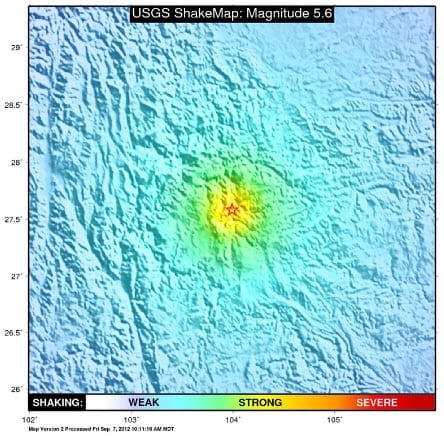 According to catastrophe modeling firm AIR Worldwide, at 11:19 AM local time this morning (3:19 UTC), a magnitude 5.6 earthquake struck southeast China, 12 km south of Jiaokui. The earthquake was followed by more than 60 aftershocks including another M5.6 earthquake, which struck 1 km south of Jiaokui at 12:15 PM local time (4:16 UTC). Both earthquakes were relatively shallow, with depths of 9.9 km and 9.8 km, respectively. The highest reported intensity in population centers is around V (moderate) in Zhaotong, which is mainly an agricultural area. At this intensity level, there is often only a minor damage, but with many people living in mud and clay dwellings, the damage could be higher due to landslides.
According to catastrophe modeling firm AIR Worldwide, at 11:19 AM local time this morning (3:19 UTC), a magnitude 5.6 earthquake struck southeast China, 12 km south of Jiaokui. The earthquake was followed by more than 60 aftershocks including another M5.6 earthquake, which struck 1 km south of Jiaokui at 12:15 PM local time (4:16 UTC). Both earthquakes were relatively shallow, with depths of 9.9 km and 9.8 km, respectively. The highest reported intensity in population centers is around V (moderate) in Zhaotong, which is mainly an agricultural area. At this intensity level, there is often only a minor damage, but with many people living in mud and clay dwellings, the damage could be higher due to landslides.
Today’s earthquake series began with an M5.6 temblor that struck the border area between Yiliang county, in the Yunnan province, and Weining county, in the Guizhou province. The damage was heaviest in the rural, agricultural areas of Yunnan and Gizhou, where more than 20,000 homes were damaged or collapsed according to the Yunnan provincial civil affairs department. The poor construction of the buildings in these areas makes them susceptible to earthquake damage. More than 100,000 people were evacuated from their homes in Yunnan.
“Today’s two M5.6 earthquakes occurred in the North-South Seismic Belt in central China, which is the site of the 2008 Wenchuan earthquake and many other recent magnitude 7.0-8.0 earthquakes,” said Dr. Bingming Shen-Tu, senior principal scientist at AIR Worldwide. “Today’s events were located to the west of those past earthquakes, about 100 km away from the major active faults in the North-South Seismic Belt. Both epicenters were located about 300 km southwest of the Longmen Shan fault zone, which generated the 2008 Wenchuan earthquake, and 100 km east of the Xianshuihe-Xiaojiang fault zone, which has historically produced many large earthquakes.”
“Historically, moderately large earthquakes have occurred along the minor faults in the east. For example, in May of 1974, a magnitude 7.1 earthquake struck Zhaotong and caused widespread damage, 60 km north of today’s events. This event occurred in a set of minor faults east of the major active faults in the region. The epicenters of today’s events occurred in a region characterized by deep stream valleys and steep slopes. The elevation contrast between mountain ridges and stream valleys typically ranges from 500 to 100 meters, and the average slope is about 30-40 degrees. Therefore, earthquakes in this region usually cause widespread landslides and rock falls, as did today’s earthquakes.”
The earthquake series triggered landslides near the mountainous border between the Yunnan and Gizhou provinces. Rocks as large as four meters in diameter tumbled down mountains, blocking roads and crushing houses in the Yiliang town of Luozehe.
Many new roads, bridges, and industrial zones are under construction in Guizhou, with hundreds of millions of dollars spent on these projects in the past year; it is currently unknown if any have been damaged by today’s earthquakes.
According to AIR, the dominant construction types in China have historically been unreinforced masonry consisting of adobe or brick, or brick with a light wood frame. The buildings are generally massive, but lack the lateral systems that can help withstand ground shaking. As a result, they often perform very poorly during seismic activity, even when the ground shaking intensity is low. Many single-family homes, particularly in rural areas, are still made out of traditional materials. However, after the 1976 Tangshan earthquake, many of unreinforced masonry buildings in urban residential areas were replaced with stronger and more affordable confined masonry.
According to AIR, most urban homes are mid-rise or high-rise apartment buildings, many of which have commercial establishments on the ground floor. Mid-rise buildings are often confined masonry while high-rises tend to be reinforced concrete. New buildings in China incorporate advanced earthquake-resistant features in their design and are also subject to better construction practices and more stringent code enforcement. Theoretically they should perform better during intense ground shaking from large earthquakes.
According to Paz (1994), the first official seismic code for China was issued in 1974 for industrial and civil buildings. The code has been revised several times with the most recent one published in 2010, after the 2008 Wenchuan earthquake. Many people believe that the enforcement of the seismic code in the area affected by today’s earthquakes has not been strict as many of the people are still living in mud and clay dwellings with little seismic consideration.
The USGS reported a Modified Mercalli Intensity of VI (strong) and higher around the epicenter.
AIR continues to monitor the situation and will provide updates if warranted by events.
For more insurance news headlines.

